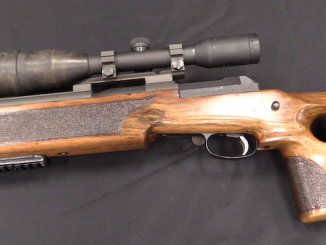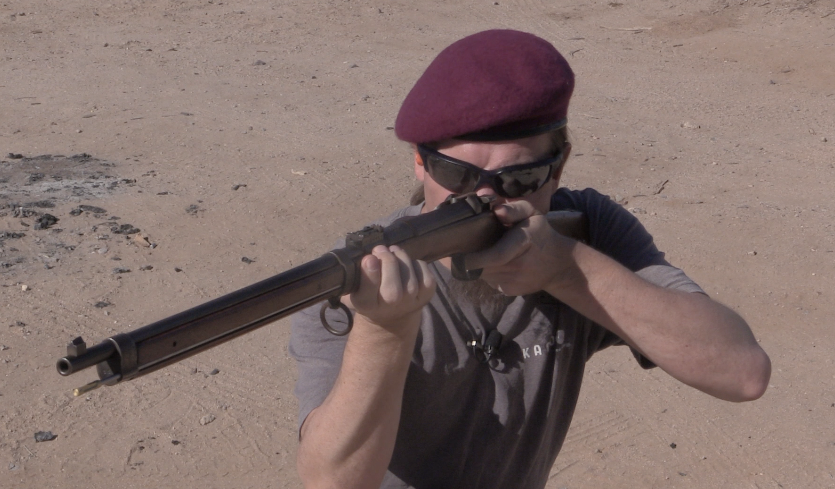After the Mp44/StG44 Sturmgewehr was starting to see substantial production and field use, the German military and the Mauser company began working on a way to simplify production of the weapon. The design for the Gerät 06H actually began with the Gerät 03, an attempt to make a roller-locked G43 rifle in 8x57mm. An accident with automatic fire and bolt bounce sparked the idea of roller-delayed blowback, and Mauser engineers incorporated this concept into a rifle in the same layout as the StG-44 and using the 8x33mm cartridge.
The Gerät 06H would successfully complete early prototype trials, and was ordered to be fully developed, with the designation StG-45(M). The next step in the process was to make a small batch of guns for extended trials. A total of 30 more guns were ordered, but they were not completed by the time US troops began threatening to overrun the Mauser complex at Oberndorf. All the most valuable material at the factory was packed into a train with the intent of reassembling the factory in a secret cave in the Austrian Alps. The train left Mauser on the night of April 21/22 1945, with the incomplete sets of StG45(M) parts aboard.
US and British military intelligence men found the train in June, and took the parts into custody. Eventually, imprisoned Mauser staff held in the Netherlands would be put to work assembling some of these rifles so they could be tested by Allied governments. The roller-delayed blowback system would find its way to Spain with a number of former Mauser men, where it was developed into the CETME rifle and adopted by Spain. The Heckler & Koch company was formed to continue this work when arms development again became legal in Germany, and the system would see massive worldwide use as the G3 rifle, MP5 submachine gun, and many other derivative weapons designs.
The rifle in this video was a set of StG-45(M) parts that found its way into private hands after the war, and was eventually purchased by Dutch gun collector and industrialist Henk Visser. He bribed the fire control parts diagrams out of the British, and used his ownership stake in Mauser to have the remaining parts (the FCG, stock, and receiver endcap) made and the whole thing assembled into a complete firearm by Mauser in the 1960s. The original trunnion shattered when proof tested, and a new trunnion was made (presumably with better heat treating…). Mistakenly thinking that 19 of the parts sets had been assembled in the Netherlands after the war, Visser had his rifle serialized as V-20, and it retains that number and a Mauser banner logo today.
The rifle today is in a private collection in Malta, where its owner and the Association of Maltese Arms Collectors and Shooters generously invited me to bring it to you on film.




Mauser was captured by French troops.
Staff was not interned in the Netherlands but in Eschede and Unterluss, Germany.
Henk Visser was sales manager of NWM, a company that was part of the conglomerate (Quandt Group) that also owned Mauser. Visser had a good relationship with Ludwig Vorgrimler, one of the R&D men of wartime Mauser and one of the developers of the CETME rifle. Vorgrimler returned to Mauser and worked at R&D until his retirement. It is very plausible that Vorgrimler helped to build Visser’s StG45 in the 60s.
This design did not need a anti-rebound lever as the spring guide also rebounded and cancelled out the bolt carrier bounce. The rotating dust cover was also made postwar. The stock screws are as per drawings. The trunnion shattered on firing because it was heat treated incorrectly.
This particular rifle is very comfortable to shoot and also very controllable on fully auto
I think the part you referred to as the hammer was the disconnector, the disconnector, the ejector, spring loaded because?
“system would see massive worldwide use as the G3 rifle, MP5 submachine gun, and many other derivative weapons designs”
Did CETME or anybody else try to adopt it for 12,7×99 NATO cartridge, that is create roller-delayed blowback system machine gun firing said cartridge? If yes what was result?
Yes. There was an experimental H&K prototype, the HK25, in the 1960s, chambered for 12.7 x 99 aka .50BMG. It was essentially an enlarged HK21, with the same attributes (quick-change barrel, belt feed, etc.).
It was not proceeded with because of its weight and the fact that at the time, nobody could figure out its exact tactical role; it was too light to be a true heavy machine gun, and too heavy and powerful to be a practical GPMG.
It must be remembered that at the time, the concept of the “anti-materiel rifle”, borne of the 13mm Mauser T-Gew and the 0.55in Boys, was largely forgotten and wouldn’t be revived until the 1980s and the general enthusiasm for “special operations”. The HK25 would seem to have been an ideal fit for that role, albeit probably forsaking the belt feed for a more rifle-like box magazine, and most likely semi-automatic only.
Information on the HK25 is sparse because only a few prototypes were ever built. However, it did apparently get into an H&K catalog;
https://web.archive.org/web/20120719013050if_/http://img339.imageshack.us/img339/226/5036282.jpg
It is listed as a “delayed blowback”, which is technically correct for the roller-locking breech. I suspect one reason it was not proceeded with was the discovery of its no doubt formidable recoil; after all, it was meant to be fired from the shoulder, off a bipod. I estimate its recoil would be somewhere around that of a non self-loading .50 rifle of today, like the Barrett bolt-action.
Except firing fully-automatically at 450 rounds per minute. Which must have made a sizable impression at both ends.
Ouch.
cheers
eon
“Except firing fully-automatically at 450 rounds per minute. Which must have made a sizable impression at both ends.”
In that advert it looks quite compact (for 12,7×99 NATO cartridge), so maybe it could be adopted as AFV weapon? With platform weight of at least few tons* recoil should be no problem.
*metric
The trouble is that even on an FAV, it would be about as easy and a lot more practical to mount a Browning M2. The HK25 with a box magazine and semi-auto only would have filled a definite need for SpecOps as an AMR, but as an MG it was neither fish nor fowl, nor really useful.
H&K did try to develop an AMR in the 1990s, the WSG2000, firing a special 9 x 90mm MEN cartridge;
https://www.militaryfactory.com/smallarms/detail.asp?smallarms_id=415
It never progressed past the mockup stage.
If they wanted to try again today, taking the old HK25, converting it to a “heavy” precision rifle along the lines of the PSG-1, and chambering it for something like .408 CheyTac (10.36 x 77) would probably be the best bet.
Taking a “rifle” designed for 12.7 x 99mm and “down-boring” it to 10.36 x 77 is going to be inherently simpler than taking a rifle designed for 7.62 x 51mm and “up-sizing” it to handle a bigger cartridge, which they already should have learned with the HK25.
cheers
eon
” FAV, it would be about as easy and a lot more practical to mount a Browning M2″
I mean, “through armour” installation especially where space is limited, as for example 105mm Gun Tank M60‘s machine gun turret.
http://www.tanks-encyclopedia.com/coldwar/US/M60_Patton.php
john
The Chinese have a roller locked 30mm grenade launcher
So happy finally the stupid cut down prone shooting 10 round stg45 magazine myth is busted !
Arent the sights a bit high related to the stock?
Awesome video Ian,bravo sir!One of these in 22 rimfire would be great for plinking at the range.